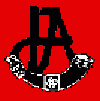Guard Force Rank Structur & Badges Uniforms Through the Century Honours, Awards Roll of Honour Picture Gallery Site Home Page
Introduction
Let me say at the outset that because of the vastness of this subject it has been necessary to glean information from a variety of sources. It has therefore, not been easy to to know what to include and what not. I hope that those who have contributed to this section are satisfied that it reasonably reflects the situation at the time and that it will persuade others to add their knowledge to the section.
The Politics
At the outset it is necessary to try to understand the politics behind the political decision to implement the construction and population of the Protected Villages (PVs) before we can understand the specifics of their implementation. This should be far more detailed and perhaps with time it will grow as other members of the Department of Internal Affairs contribute to the section.
Early in 1973 intelligence was received that a cadre of Zanla fighters was living and operating within the Chiweshe Tribal Trust Area.
(For clarification a Tribal Trust Area was a large tract of land that was prescribed by law to be used and occupied exclusively by the black population of the area. It was not possible for the land to be purchased by an white member of the population. These areas were administered by the Department of Internal Affairs and a District Commissioner was responsible for the overall control of the administration of the area. Contrary to some stories spread by those who set out to denigrate the system the land was not poor in agricultural terms but identical to that occupied by the white farming population who had purchased farms in the surrounding area.)
Zanla Cadre at work
This Zanla cadre had been hard at work indoctrinating and politicizing the local population by the use of their normal methods of intimidation. The level of intimidation increased daily and took the administration by surprise as is was not possible for a normal human being to comprehend the things that were being done in the district. The local inhabitants who did not want to co-operate with the Zanla cadre were subjected to the most brutal beating and torture in order to force others to comply.
This was happening in a Tribal Trust Land within 30 miles of Salisbury(now Harari) and sent all sorts of shudders through the senior officers and the politicians. All the atrocities committed were reported in Sitreps (situation reports) as taking place in the North East. This was a vague geographical area, that gave the impression that the activity was taking place far away on the Mozambique border and was therefore of little or no concern to the "man in the street" in Salisbury, just a 45 minutes drive away by motor vehicle. The following photographs taken from the book Contact by John Lovatt, show graphically the horror that the local population were subjected to the Zanla terrorists. They were taken in Chiweshe and attributed to Camelot.
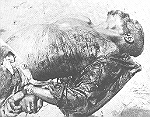
This village headman had his hands bound and was shot to death.
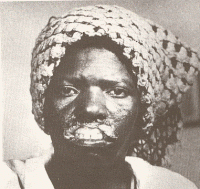
This mans wife was forced to cook and eat her husbands severed lips and ear.
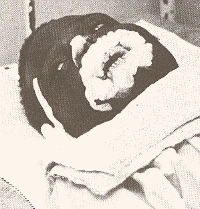
A number of methods were tried to contain this threat and very early on the security forces had some success with Jack Chamunorwa and his group, but thereafter it became a real game of cat and mouse, which produced minimal results.
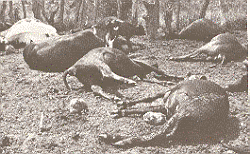 An indication of the political sensitivity of this area was only one Territorial Force unit, the 4th.Battalion Rhodesia Regiment from Manicaland, did a tour of service in the Chiweshe Tribal Trust Land, the remainder of the period the area was occupied by all regular army units, mainly Rhodesian African Rifles.
An indication of the political sensitivity of this area was only one Territorial Force unit, the 4th.Battalion Rhodesia Regiment from Manicaland, did a tour of service in the Chiweshe Tribal Trust Land, the remainder of the period the area was occupied by all regular army units, mainly Rhodesian African Rifles.
The 4th.Batalion were redeployed to Buhera were they suffered a number of casualties.
There was yet another serious consideration to take into account. Chiweshe was very rich agricultural are, nestling in the heart of the Mazoe Valley producing maize, cotton, citrus and tobacco. It was the home to the regionally famous Howard Institute, a Salvation Army primary and secondary school, with a very sophisticated hospital attached. Many of the young men and woman of Chiweshe went to Salisbury to find employment. Stories of the apparent success of the Zanla terrorists in Chiweshe, was being carried to Salisbury. They were, it was said taking on the Rhodesian Forces and appeared to be winning. This encouraged more political unrest and opposition.
Change of Plan
Whoever planned the infiltration route through the Sipolilo and Mt. Darwin areas was enlightened. The terrorists had tried to infiltrate Rhodesia via the inhospitable Zambezi Valley from Mana Pools to Victoria Falls without success. Animal infested areas with sparse populations, who were very suspicious of any stranger of whatever race or tribe had not been successful. By infiltrating through the North East they had been successful. They used Tribal Trust Lands all the way from the border to the escarpment and above, then with just a short hop across commercial farm land and into the Chiweshe Tribal Trust Land. Another route was across the Mt Darwin commercial farms and into the vast Tribal Trust Lands of Shamva. In later years, with the collapse of the Portuguese the route was through the Honde Valley, Mutasa South, Manyika, Makoni and into Whedza. From there it was just a short hike to Seke on the outskirts of Salisbury. From the north a short hike down to the bottom of Mutoko and again they were on the outskirts of Salisbury.
Decision Made
As the threat escalated in Chiweshe it had to be, from a political point of view, contained. This decision was taken by the National Joint Operations Command (Nat JOC) as the army had acquired experience in Malaya, Kenya and latterly from Vietnam. There was a great difference of opinion within The Ministry of Internal Affairs (Intaf), for the reasons explained in the book "The Hidden Conflict", but as the Secretary of the Ministry was a hawk, the operation was given the go ahead.
Bill Johstone (District Commissioner Concession) was briefed at Centenary and came back and told Tim Dufton and Alex Deere that they had to move 45,000 people, their houses, belongings and their livestock within a very short time frame.
Our first action was to visit every village in Chiweshe to tell them they would be moved and they should give consideration as to whom they wanted to live next to in the Protective Village. The area was scouted for potential sites for the Protected Villages. At that stage there was no plan for the Protected Village, but having been to visit the Aldementos in Mozambique, those involved had an idea of what was required. 21 sites were selected and the work od constructing the Protected Villages began. The teams worked as much as 20 hours a day. This huge task was named "Operation Overload" a crib on the famous Operation Overlord in Europe. The staff increased from 15 people to over 500.
Layout of the Protected Villages
There was no plan for a standard village. Each one was designed to fit the surrounding terrain. Basically it was rectangular in shape, security fenced with a Keep (fortified section) in the centre to house the Intaf staff who administered Protected Village.
The logistics were horrifying.
21 Keeps, accommodation for the Black & White staff, water,sanitation,security & this extended to the entire complex. Provision was made for water, sanitation, schools, stores, medical facilities and an areas for livestock, where they would be secure. In addition the recruitment and training enough men to carry out this onerous task was difficult. Initially Districts Assistants from all over the country were seconded to Chiweshe. Sadly, some of the best from Kariba were lost in actions with the terrorists.
The deadlines to complete this task were very tight.As the program progressed it was a matter of get started & finish as soon as possible.
Financial Cost.
The Chiweshe programme was the show piece for the country and cost in excess of $3million. In 1978 when the same plan was implemented for the Sipolilo Tribal Trust Land, at the request of the locals, the surrounding commercial farmers were asked to contribute, with transport for materials and the farmers were asked to ask to adopt a Protected Village and help pay for the infrastructure as Government did not have the the finance to do it. This they willingly did and provided a magnificent service in the endeavor to save their local communities.
Reaction to the programme
There was a large Catholic Secondary School run by the Church in Umvukwes. The Headmaster was dragged before the assembled school, accused of being a sell out and executed. The local population, who had witnessed this were told not to move his body under threat of death. A few days later the murder of the headmaster was brought to the attention of the Priest in Umvukwes. He drove, on his own, into what was extremely hostile area and took the body back to Umvukwes for a Christian burial. When the people were told about the intended plan to build building a village around the school they returned all the corrugated iron, that they had taken off the roofs of the school buildings together with the water pump and pipes that they had hidden.
With hind sight the introduction of Protective Villages was successful in that they saved many lives over the years and many Africans who were forced to live in them have said the same. The younger generation loved living in the PVs as everything was on the doorstep and it was like living in town. The terrorists struggled to find an answer to the Protective Villages. One of their counters was that the Protective Villages were "Concentration Camps". They promoted this view to great effect.
There is however, another aspect to the showpiece Protected Villages of Chiweshe They provided a good propaganda tool against this accusation,. The villages fenced to secure the inhabitants from terrorist indoctrination and physical harm. They were well illuminated, had adequate clean water, schooling and medical care. Each village even had it's own radio station.
The Guard Force
As the war escalated and more PV's were built, the strain on the Ministry of Internal Affairs to provide the required personal became prohibitive. It was argued that National Servicemen were required to guard the people and patrol the area. The Police were stretched as was the Army. This eventually led to the formation of the Guard Force.
These young men were undertrained and ill equipped as it was never intended that this should be their role. Many of them saw more hostile action in a week than most permanent Security Force members saw in a couple of months. They were, totally and unreasonably, maligned and treated like inferior forces. Amongst them were some true heroes who will never be recognized although they were placed in situations of great danger. Perhaps some of their stories will be told in time.
Our thanks go to those who contributred to the above article.
